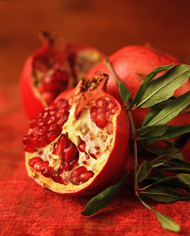“Love winter,” wrote the poet-monk Thomas Merton, “when the plant says nothing.” Would that this were so for me, but when the ice winds of late January undress the last of the garden fruit trees, rather than abiding in dormant silence these plants begin to whisper in tongues, unraveling their long, winding stories. Whether I know the plants well or not makes little difference, as I learned last year while visiting the garden of some dharma friends in Sacramento for the first time.
Liliana had just moved into her father’s house in a quiet neighborhood in eastern Sacramento. Ernesto, her father, had died a few months before, and Liliana was still in the talons of grief. She and her husband were unpacking boxes when I arrived on a damp midwinter afternoon. We went outside into Ernesto’s garden and stood in the chill rain under the huge shelter of two old pomegranate trees that border his place. Massive suckers pushed up out of the raw wet earth, and the bare branches of the pomegranate clicked and chattered overhead.

The pomegranate, or “seeded apple,” is an ancient fruit native to Persia; archaeological records of this plant date back to 3000 B.C.E. It is valued for its medicinalproperties and has long been associated with fertility, death, and rebirth: we know, for example, that pomegranates were buried in King Tutankhamen’s tomb. Believed by many to be the authentic fruit of the Garden of Eden (since the domestic apple was not in cultivation during biblical times), the pomegranate was prized by the prophet Muhammad, who encouraged his followers to partake of it for its nutritional and spiritual value. And in the Greek myth of Persephone’s descent into the underworld, only her taste of the forbidden fruit of the pomegranate ensured her annual return to Hades.
On my Sacramento visit to Ernesto’s garden I spent the night with my friends, waking up at dawn to have breakfast with them before heading home. On the table Liliana set out a small jar of homemade jelly, dark garnet red and densely fragrant. “Pomegranate,” she whispered, spreading the rich fruit on my toast. It seemed that in mid-autumn, when her father was most ill, three Middle Eastern women had knocked on his neighbor’s door and asked if they might gather the fallen pomegranates covering the ground beneath Ernesto’s trees. These women—mother, daughter, and grandmother—were staying nearby at the Shriners Hospital. The son of the youngest woman had been severely burned and was in the critical-care unit of the hospital. They were far away from home and from their own pomegranate trees. Every year, they made a traditional holiday jelly from this fruit.
The neighbor gave the women bags to fill, and they busied themselves with the harvest, preparing their conserve in the small kitchen of the hospital guest-house. On Thanksgiving Day, Ernesto’s neighbor brought him the surprise jar of pomegranate jelly she had discovered on her doorstep. “I haven’t been able to taste it until today,” Liliana confessed.
Thank you for subscribing to Tricycle! As a nonprofit, we depend on readers like you to keep Buddhist teachings and practices widely available.